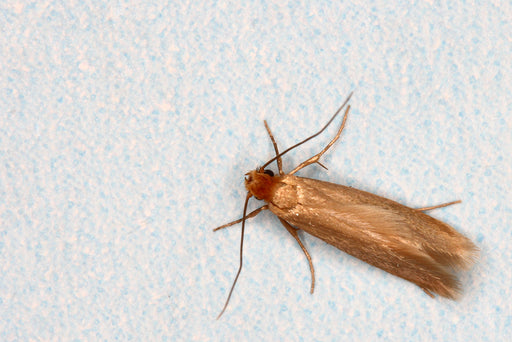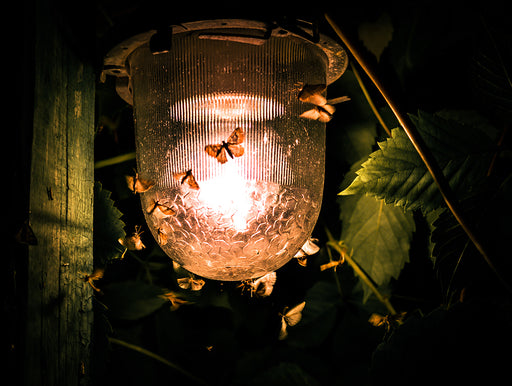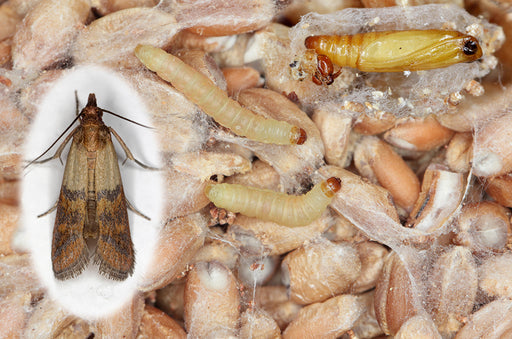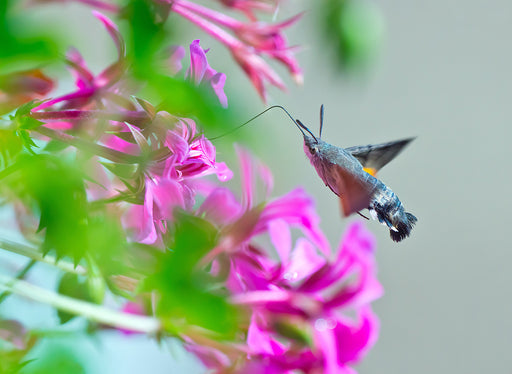How to Catch a Moth - The Guide to Moth Trapping

Your Ultimate Guide to Moth Catching and Moth Prevention for Just About Any Situation
Picture this: You’re trying to read your book before bed, but a moth has flown into your house and is relentlessly fluttering around your head. You swat at it and try to grab it with your hands, but it maneuvers up to the ceiling, just out of reach. Now, it’s taunting you from above. What are your options? Do you throw a slipper at it? Should you try to employ your cat as a moth-catcher? Are you about to give up and accept that now you have a roommate?
Or, maybe you have a more dire situation involving destructive Clothes Moths. You have noticed that something is eating holes through your clothes in the attic and are sure moths are hiding around your house somewhere. However, you can’t figure out how to find or catch them. How frustrating!
No matter what your moth problems are, you’ve come to the right place. In this comprehensive “How to Catch a Moth'' guide, we will walk you through everything and anything you could ever want to know on the subject. Plus, we’ll provide some great tips on how to catch a moth (or multiple moths) and give you in-depth instructions on the process. Let’s get to it!
How to catch a moth in your house?
Quick Answer: If you are wondering how to catch a moth in your house, first, identify the type of moth. Generally, non-harmful Garden and Miller moths fly into homes looking for shelter from damp or cold weather. Sometimes, moths are also attracted to artificial light sources in houses. Harmless moths can be caught in nets, plastic bags, bucket traps, or even using large cups with wide mouths. They can also be trapped by hand or lured back outdoors using light sources.
About Catching Clothes or Pantry Moths
To catch invasive Clothes Moths, Pantry Moths, you may need to use Moth Traps, pesticides, or other extermination products. These smaller moths are harder to see and tend to hide in dark crevices. They rarely flutter near light sources and require an in-depth understanding of pest control. Since their larvae can cause serious damage to items in your home like food or clothing, you should do everything you can to get them out of your house right away. We’ll get into the details of this process in the article below.

Ways to Catch Moths:
• Lure Moths Outside with Light
Some types of moths fly into the house looking for light sources. These moths are usually harmless and can be lured out of the house by turning off all of the lights except for one bright light source outdoors.
• Professional Moth Traps
Professional Moth Traps can be used to catch pestilent moths such as Clothes Moths or Pantry Moths. These traps catch and hold moths to prevent them from laying eggs in your home. Most of these traps even have special pheromones to lure moths in.
Understanding Moth Behavior
When you are trying to learn how to catch moths or eliminate them from your home, you should first have a general understanding of moth behavior. Different species of moths will behave in different ways. Here are some behavior patterns and explanations to help you get a better idea of what to expect from different types of moths.
Facts and Behavior Patterns of Moths That Fly Toward Light
As we stated above, some kinds of moths are attracted to light. Moth species like migrating Miller moths, Sphinx moths, peppered moths, garden moths, and many more, may be attracted to the lights in your home, on your garden patio, or on your porch. If you've ever heard the expression “like a moth to a flame”, you know what we are talking about. To see the phenomena for yourself, just turn on your veranda lights at night in the middle of July or August and watch the moths come fluttering in.
Mothing or LightSheeting Attracts Some Types of Moths
This phenomenon is so well-observed that many people enjoy a hobby called “mothing” or “light sheeting”. According to the Natural History Museum, this process involves setting up a light source outside and providing a wide surface (usually a sheet) for moths and other flying insects to land on when it’s dark at night. These light sheets attract certain insects that can then be observed up close. As the moths come fluttering in, people who enjoy this hobby take pictures of them and study them to learn what insects live in their area and more. There are even a few mobile applications that can be used to help catalog moths!
Not All Moths Will Fly Toward Light Sources
If you are trying to catch moths or position Moth Traps, it is important to note that not all types of moths are attracted to light. Some moths experience negative phototaxis, or, repulsion from light. Clothes Moths and Pantry Moths, for instance, prefer dark crevices, cracks, and shadowy areas, so consider these areas when placing your Traps. Some cave moths such as the Tissue Moth (Triphosa dubitata), will actively fly toward deep, dark crevices.
Why are Moths Attracted to Light?

If you’re trying to catch a moth, understanding why certain species are attracted to lights can be useful to know. So why exactly do some moths fly toward your lights, anyway? The attraction of a moth to light involves a scientific phenomenon known as positive phototaxis. While the phenomenon has a name, there are differing opinions on the actual reasons that certain moth species are attracted to lights at night. Some theories suggest that a moth’s navigation is disrupted due to confusion between lights and the moon. Others speculate that ultraviolet electromagnetism causes moths to fly toward artificial lights
The UV Spectrum Theory
In the 1970s, researcher Philip Callaghan contrived a theory about moth attraction to light involving UV waves and the electromagnetic spectrum. This UV and infrared light theory revolved around female moth pheromones, molecules, and photons of infrared microwave radiation causing confusion and mating behaviors. However, his theory did not gain as much traction because both male and female moths seem equally as attracted to light.
Navigational Disruption and the Contrast Shadow Theory
Other scientists theorise that moths are not actually attracted to light as much as they are lured in by the dark areas of contrast near a bright light source. The “light and shadow contrast” idea suggests that radiant lights confuse a moth’s sense of brightness and darkness. With this hypothesis, it is thought that the moths are trying to access the negative, darker spaces behind or near the light source to find places to hide.
Moths May Mistake Artificial Lights for the Moon and Stars
Still, other individuals believe that moths mistake artificial lights at night to be the moon and/or stars. If moths use starlight and moonlight to navigate or adjust their positions in the sky, artificial lighting could cause them to become disoriented or confuse their navigational instincts. Moths want to stay parallel to the ground, so they try to fly upward, toward light sources in the night sky.
How to Catch a Moth Indoors Using Light Sources
Now that you know all about moths and why some of them are attracted to light, you can use this information to your advantage when getting them out of your house. One method to catch moths involves using the lights in your home and on your patio. This method is great for people who want to know how to catch a moth without touching it. Although this method won't work for all types of moths, it can be great for the ones that are fluttering near your lamps or flying around near the lights of your ceiling. Here's how to do it!
Step 1: Make Sure the Moth is Attracted to Light and Active
For this method to work, you will need a moth to be actively fluttering around and trying to access areas where bright lights are shining. If a moth has settled down or run out of energy, you should use a different method. So, study the moth in your house. Is it trying to fly toward light sources? Does it seem to have lots of energy? If so, then this method will probably work well for you.
Step 2: Systematically Turn Off Your Lights
Moths that are attracted to lights tend to be very strongly drawn toward light sources. As such, the goal here is to systematically turn off the lights in your home to lure a moth back outside. You will turn all of the lights off in your house leaving only one light on near your patio. As the moth seeks new light sources to chase, it will usually fly back outside where it belongs. If a moth doesn't immediately head toward the light you leave on outside, you can use a piece of paper or magazine to help usher it in the right direction.
This Method is Great for Pesky Active Moths at Night
With active migrational moths like Millers, this method works surprisingly well. In fact, as soon as you shut off the light that the moth is trying to fly toward, it will usually immediately try to find the next nearby light source. So, you can turn off the lights in your house one room at a time or simply open a window and use the flashlight on your phone to draw the moth out. In any case, if a pesky moth is obviously chasing light sources in your room (like flying at lamps, around the TV, or landing on your phone screen), this is a great way to get it back outside.
Pantry and Clothes Moth Behaviors

So what about moths in your home that aren't attracted to light? Well, if a moth isn't attracted to bright light sources, it’s actually a decent indicator that the moth is a pest species. There are indeed a few harmless types of moths that will flutter into houses looking for warm, dry places to hide. Sometimes, these moths aren’t attracted to lights but also aren’t harmful. With that being said, the fact stands that most pest moths like Clothes Moths and Pantry Moths enter homes for far more nefarious reasons. Pestilent moths like these can cause infestations and their larvae eat through items of clothing and textiles made from animal based fibres, and dry food goods.
Clothes Moths, Carpet Moths, Pantry Moths, and other pest species are not attracted to light and will instead seek out dark, quiet places to lay eggs. This can be a real problem! In many cases, these pests hitch a ride into your home in the larval stage and it’s the larvae that eat through your belongings until they can spin cocoons and hatch into adults. At this point, they will breed, and the whole process repeats. No one wants that!
How to Catch a Moth in My Room That’s Eating Clothing?
Let's pretend that you open a chest of clothes to get out one of your favorite winter sweaters from last year. As you pull the sweater out, you notice that it has little holes eaten through it. Now you are angry! You suspect that a moth has done this damage, and are determined to catch it. Here's what to do!
First, Know Your Enemy
Bear in mind that those holes in your sweater or item of clothing are caused by the moth larvae, not a fluttering adult. Here’s how it works:
• A Female Moth Lays Eggs
Yes, female Clothes Moths can fly into your home and lay eggs. However, more often, they lay eggs on an item that you have unknowingly carried into the house. Used furniture or clothing from thrift stores are items that often contain hidden moth eggs.
• The Eggs Hatch Into Hungry Larvae
Next, the moth eggs hatch into ravenous little larvae. These larvae start out small and grow as they eat through natural materials like silk, feathers, wool, soiled cotton, and even leather.
• The Larvae Grow and Pupate
As the larvae eat through your belongings, they grow bigger. Often, moth larvae will leave evidence behind. Evidence of moth larvae may include casings, dead larvae, live larvae, webbing material, cocoons, and detritus. After a certain amount of time (anywhere from a few weeks to many months), the moth larvae will spin cocoons. Then, they will emerge from the cocoons as adult moths.
• Adult Moths Mate and the Cycle Repeats
Once moth larvae grow into adults, they emerge from their cocoons and look for mates. After mating, an adult female Clothes Moth will find a suitable place to lay the next generation of eggs. So, if you see an adult Clothes Moth in your home, one of two things is probably going on:
- The adult Clothes Moth is looking for a place to lay her eggs in your house.
- The moth just emerged from its cocoon and is looking for a mate.
Catching Pestilent Moths: You Must Eliminate These Moths at All Life Stages

If you see moths flying around your home then you will need Moth Traps to catch the active adult males. To eliminate the moths, eggs and larvae completely you will need a Moth Killer Kit. So while catching adult moths is important, eliminating eggs and larvae is equally essential to stop the life cycle.
How to Catch Clothes Moths
There are three things that you need to do to catch Clothes Moths in your house. First, figure out where the infestation is coming from. Then, eliminate all eggs and larvae. Finally, be sure to catch any adult moths that are in your home.
Use Moth Traps for Adults
For adult Clothes Moths, Moth Traps are very effective. Moth Traps are great because they can catch many moths at once. Plus, evasive species of moths like Clothes Moths are hard to catch with your bare hands or even a net. This is because they are almost always hiding in dark crevices. These traps can easily help you catch moths.
Eliminate Eggs and Larvae with Moth Killing Products
There are many products available to kill the Moths, moth eggs and larvae. For Clothes Moths, fumigation products, moth bombs, and pesticide sprays, which are found in our Clothes Moth Killer Kits, are great. Just follow any instructions carefully so that you don’t cause problems for your pets, kids, or yourself. You may also want to freeze any clothes or fabrics for at least 72 hours to kill hidden eggs or larvae.
Pantry Moth Behaviors
Pantry Moths are a lot like Clothes Moths in that they like dark quiet places and lay eggs that hatch into hungry larvae. As with Clothes Moths, Pantry Moths are most harmful in the larval stage. Pantry Moth Larvae eat cereals, grains, flour, and pretty much any other dry good which is left unsealed or exposed.
Pantry Moths can be very hard to see, and often hide in dark crevices or under lids. When catching Pantry Moths, non toxic Pantry Moth Traps can be extremely effective. You will also need to clean out your whole pantry and any other areas where dry food is stored in your home. The goal is to stop an infestation in its tracks.
Pantry Moths differ from Clothes Moths in that they eat dried food goods and should not be killed with chemicals. After all, you don't want to use pesticides, mothballs, moth-killing sprays, or fumigation products near your eating areas.
How to Catch and Kill Pantry Moths?
To eliminate an infestation of Pantry Moths, you will need to scour your entire pantry, shelves, and any other areas where you keep food, using a natural Pantry Moth Killer to get rid of moths, eggs and larvae.
Thoroughly wash all shelves, food storage jars and lids, and anything in your pantry where a clutch of sticky eggs could be hiding. Throw away any food items that are infested. Then, position Pantry Moth Traps to catch the adult male moths. You can also make moth-deterrent sachets filled with rosemary, cloves, thyme, lavender, and mint to keep them from returning.
FAQs on How to Catch Moths in Your House, Garden, and More

Now that you know all about moths and their behaviors, let's quickly answer some frequently asked questions on the subject of catching moths.
How can I catch moths?
The easiest way to catch adult moths is by using Moth Traps which attract the active adult male moths by using powerful female pheromones on the sticky strip surface. Moth Traps save you from having to run around your house trying to shoo moths out the window or catch them in a cup. If a moth is attracted to light, you can always try to lure it back outside using a bright light source. Otherwise, a Moth Trap is the most painless solution, giving you the opportunity to monitor for moths while helping to break the breeding cycle.
What are moths most attracted to?
Moths are attracted to different things depending on their species. Some moths are attracted to bright lights while others are attracted to warm dry areas as they seek shelter from the elements. Other more pestilent moths (like Clothes Moths and Pantry Moths) are attracted to dark, quiet areas with abundant food sources where they can lay eggs.
Pestilent moth species such as Pantry Moths like quiet, undisturbed areas with dried goods such as grains, flour, starches, cereals, or pet foods. Clothes Moths like quiet dark places with lots of animal based fibers like silk, wool, fur, leather, and feathers for their larvae to eat.
About MothPrevention
MothPrevention® speak to customers every day about their clothes moth issues - clothes moths are a species that are ever increasing and that can cause significant damage to clothes, carpets and other home textiles.
To date, we’ve helped over 250,000 customers deal with their moth problems. We have developed professional grade solutions including proprietary pheromones and trap design engineered to the highest production standards.





